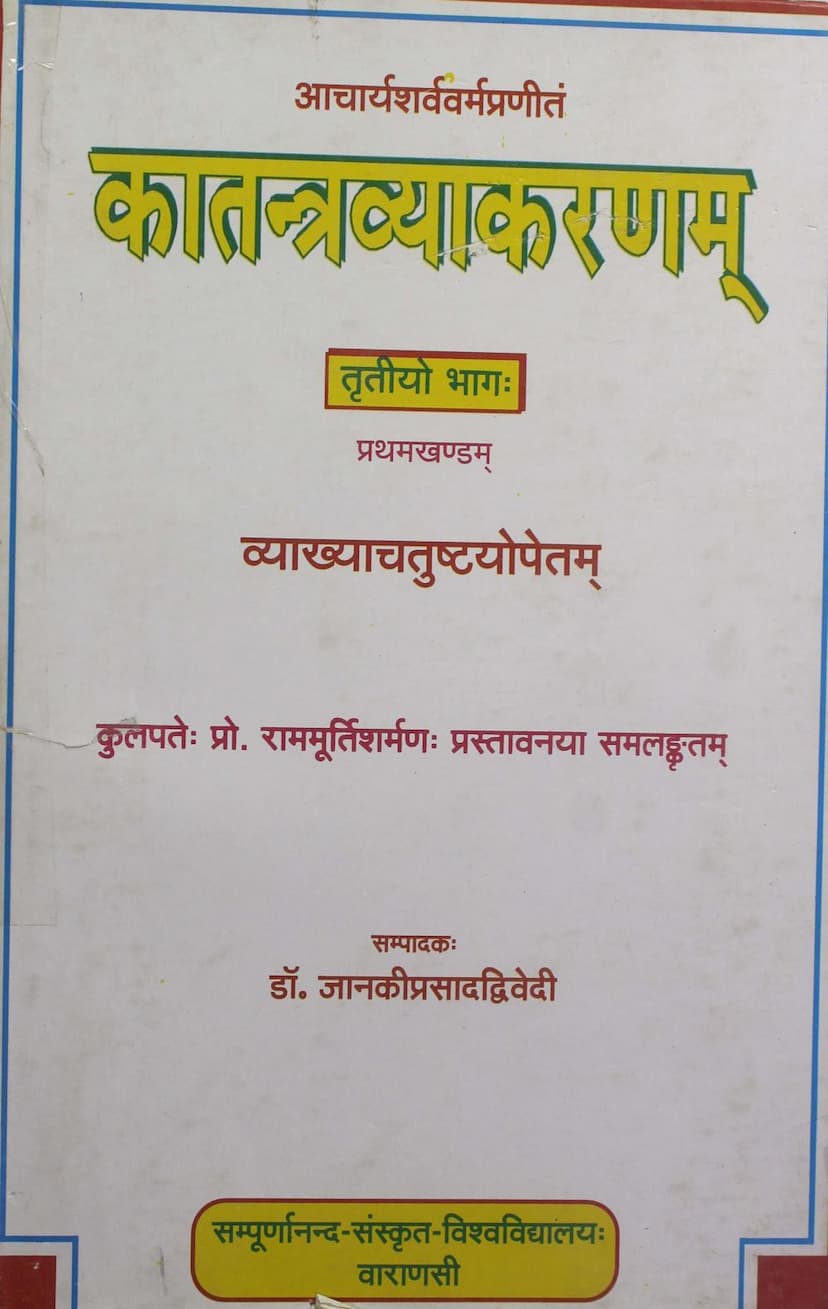Katantra Vyakaranam Part 03 Khand 01
Added to library: September 2, 2025

Summary
This document is the third volume, first part of the Katantra Vyakarana, attributed to Acharya Sarvavarma. It has been edited by Dr. Janaki Prasad Dwivedi and published by Sampurnanand Sanskrit Vishva Vidyalay, Varanasi, in the year 2000 CE. The work is a comprehensive grammatical treatise, accompanied by four commentaries:
- Sri Durgasigh krita Katantravrtti-Tika (by Sri Durga Singh)
- Sri Trilochanadas krita 'Katantravrtti Panjika'-Tika (by Sri Trilochanadas)
- Kaviraja Sushena Sharma krita 'Kalapachandra'-Tika (by Kaviraja Sushena Sharma)
- Acharya Bilveshvara krita Tikka (by Acharya Bilveshvara)
Additionally, it includes an editorial review ('Samiksha') by the editor and a foreword by Prof. Rammurti Sharma, the then Vice-Chancellor of Sampurnanand Sanskrit University.
Key aspects and content of the book, particularly focusing on the initial sections provided:
-
Introduction (Prastavana):
- The foreword by Prof. Rammurti Sharma highlights the importance of grammar ('Vyakaranashastra') as the "medicine of language" and the "essence of the Vedas."
- It positions grammar as a path to liberation, analogous to Yoga Sutras for mental peace and Ayurveda for physical health.
- Grammar is not just for understanding textual ambiguities but for achieving eloquent speech.
- It traces the tradition of grammar to Maheshwara (Panini) and Mahendra (Katantra). The Maheshwara tradition is characterized by pratyahara (sound grouping), artificial structure, and brevity. The Mahendra tradition, represented by Katantra, is described as being closer to popular usage, emphasizing conciseness, and revealing "economic meaning" (arthalaghava).
- Katantra Vyakarana, also known by names like Kalapa, Koumara, Sharvavarmika, and Durgasimhiya, is praised for its simplicity, brevity, emphasis on local usage, and clarity.
- The foreword mentions the rich literary tradition of Katantra, including numerous commentaries, translations, and derivative works in various scripts and languages.
- It notes the particular respect Katantra receives within the Jain community, referencing conferences and publications dedicated to it.
- The influence of Katantra is acknowledged in Pali (Kaccayana) and Tamil grammars.
- This specific volume, Part III, Khand I, focuses on the Akhyata (verbal) section and includes four commentaries and an editorial review in Hindi.
- The foreword details the publication history of previous volumes of Katantra Vyakarana from the same university.
- It acknowledges the editor, Prof. Janaki Prasad Dwivedi, for his contributions to Katantra studies, including receiving awards.
- The foreword concludes with thanks to the publication team and a prayer for the book's benefit to readers.
-
Editorial Introduction (Bhumika):
-
The editorial introduction by Prof. Janaki Prasad Dwivedi elaborates on the structure and content of the Katantra grammar, referencing the famous mnemonic "Modakam dehi."
-
It explains the content covered in the previously published volumes (Part I: Sandhi, Part II: Nama - four chapters).
-
This volume, Part III, Khand I, deals with the Akhyata (verbs) and is divided into three padas (sections):
- Parasmaipada: Covers definitions related to verbal forms (18 pratyayas for parasmaipada and 9 for atmanepada), the concept of kala (time), and specific conjugations like vartamana, sapthami, panchami, hyastani, adyatani, etc.
- Pratyaya: Discusses pratyaya definitions, specific pratyayas like san, yin, kamya, ayi, in, ya, aya, the use of auxiliary verbs (anupruga), and various vikaranas (an, yan, nu, n, u, na). It also contrasts Sarvavarma's general rule for atmanepada and parasmaipada with Panini's specific rule concerning krtaprayaya and anubandha.
- Dvivachana: Deals with the rules of duplication (dvvivachana), including prohibitions, phonetic changes, and specific rules for consonants and vowels.
-
Key Features and Analytical Points: The introduction delves into several unique aspects of Katantra Vyakarana and its commentaries, including:
- The author's intention to make grammar accessible.
- Durga Singh's compilation of 180 pratyayas under ten vibhakti (case/tense) categories.
- The anarthak (meaningful) names given to the ten vibhakti categories, contrasting with Panini's lakara system.
- The chandovat sutrani (verses as rules) principle, allowing for elision of letters in vibhakti and pada words.
- The four types of shesha (residue) according to Vararuchi.
- The duplication of certain prefixes (upasargas) like pra, sam, upa, ud.
- The commentators' practice of examining the meaning and drawing conclusions.
- A detailed breakdown of the reasons behind specific grammatical rules, termed prayogana (purpose), categorized by: agunartham (for non-quality), anuktasamuccayartham (for including unmentioned items), ishtartham (for desired meaning), uccaranartham (for pronunciation), uttarartham (for subsequent rules), ubhayasamjñānirāsārtham (for avoiding dual designation), gauravanirāsam (for avoiding complexity), dvvivachanārtham (for duplication), nimittārtham (for cause), niyamārtham (for regulation), paramatadarśanārtham (for showing other schools' views), pūrvāchāryamatadarśanārtham (for showing previous teachers' opinions), pratipaṭṭigauravanirāsam (for avoiding complex apprehension), pratipaṭṭilāghavārtham (for ease of apprehension), pratipaṭtyartham (for apprehension), prācīnaprayogadarśanārtham (for showing ancient usage), bādhakabādhanārtham (for overriding opposing rules), bālābodhārtham (for understanding by children), mangalārtham (for auspiciousness), mandamati bodhārtham (for slow learners), yogavibhāgārtham (for splitting rules), rūḍhyartham (for conventional meaning), lāghavārtham (for brevity), vicitrārtham (for varied meaning), vipratipattinirāsaartham (for resolving contradictions), vibhāṣākhyāpanārtham (for indicating option), viśeṣaṇārtham (for qualification), vispaṣṭārtham (for clarity), vyavasthitavibhāṣārtham (for regulated option), vyāmiśrapratipattyartham (for mixed apprehension), śaṅkānirāsaartham (for removing doubt), śiṣyabodhārtham (for student understanding), samjñāsmaraṇārtham (for recalling designations), samastalopārtham (for total elision), sasvarārtham (for full pronunciation), sāmanādhkaraṇyārtham (for co-reference), sukhānirdeśārtham (for easy indication), sukhaparihārārtham (for avoiding difficulty), sukha-pratipaṭtyartham (for ease of apprehension), and sukhārtham (for ease).
-
The editor's introduction also discusses a national seminar held in Delhi on Katantra Vyakarana, highlighting the participation of various scholars and the key themes discussed, including the methodology of Katantra, its historical importance, and its influence on other grammatical traditions.
-
In essence, this document marks the publication of a significant portion of the Katantra Vyakarana, a foundational text in Sanskrit grammar, with a particular emphasis on its detailed explanation through multiple commentaries and an in-depth analysis of its grammatical concepts. The editor's introduction provides a scholarly perspective on the text and its historical context, especially within Jain intellectual traditions.